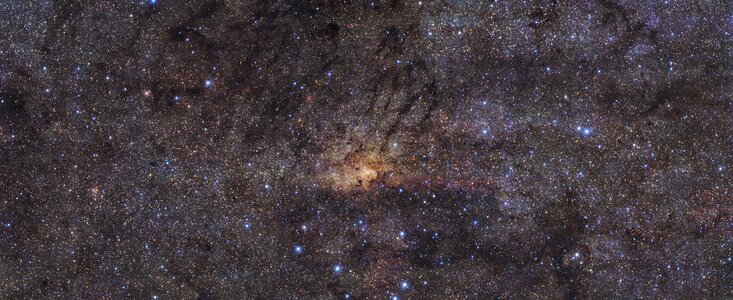Spanish Involvement with the European Southern Observatory

Milky Way’s central region taken as part of the GALACTICNUCELUS survey at the VLT. (Credit: ESO/Nogueras-Lara et al.)
Spain joined ESO as a Member State on 14 February 2007. Since then, the country’s community of scientists and engineers, as well as its industry, have been making key contributions to ESO’s projects.
Spain currently contributes 7.94% of ESO’s revenue (2021 contribution), worth 15 247 000 EUR.
As of mid 2022, there are 50 Spanish nationals employed at ESO, 39 in Germany and 11 in Chile. Furthermore, ESO has awarded 21 studentships and 13 fellowships to Spanish nationals since 2004, as well as five internships since 2014.
The current Director General of ESO, Xavier Barcons, is from L’Hospitalet de Llobregat, Catalonia. Additionally, Spain is represented in the various ESO governing and advisory bodies by astronomers and policy experts; the current Spanish representatives of ESO’s various committees with national representation can be found here.
The ESO Science Outreach Network (ESON) includes Spanish representatives who act as ESO’s media and outreach local contacts.
Here follows some information about Spain's involvement with ESO.
Discoveries by Spain-based astronomers using ESO telescopes
Spanish scientists and those based at Spanish institutions have been involved in several important discoveries using ESO facilities, including
- Using the ESPRESSO instrument at ESO’s Very Large Telescope (VLT), a team, including Spanish astronomers, measured the lightest exoplanet ever with the radial velocity technique, finding the planet to have half the mass of Venus.
- The GALACTICNUCLEUS survey, which uses data acquired by the HAWK-I instrument on the VLT, to obtain stunning images of the Milky Way’s centre and make important discoveries, including about the star-formation history of our galaxy. The survey’s Principal Investigator Rainer Schödel is based at the Instituto de Astrofísica de Andalucía, while Francisco Nogueras-Lara, who has been the first author on many GALACTICNUCLEUS papers, was based at the same institute until 2019. In that same year, Nogueras-Lara led a study that found evidence for an ancient starburst near the Galactic centre.
- Using ESO’s foremost planet-hunters HARPS and UVES on the 3.6-metre telescope and VLT, respectively, Ignas Ribas (Institut d’Estudis Espacials de Catalunya, Institute of Space Sciences) and collaborators discovered that the nearest single star to the Sun, Bernard’s star, hosts a so-called super-Earth.
- Rafael Martín-Doménech at the Centro de Astrobiología in Madrid who led one of the teams that, by using ALMA, found the ingredient of life around infant Sun-like stars.
- A Spanish astronomer (Pilar Ruiz-Lapuente, University of Barcelona) who was a member of one of the teams that discovered the accelerating expansion of the Universe. This work, made possible in part thanks to observations at ESO’s La Silla Observatory, was awarded the Nobel Prize for Physics in 2011.
Spanish involvement in ESO instruments and telescopes at ESO sites
Spain has contributed to many aspects of ESO, including the technology behind instruments at telescopes based at ESO sites. These include
- The Instituto de Astrofísica de Canarias, which is part of the consortium behind ESPRESSO, the Echelle Spectrograph for Rocky Exoplanet and Stable Spectroscopic Observation instrument at the VLT.
- The Instituto de Astrofísica de Canarias is also part of the consortium behind the expert planet hunter NIRPS at ESO’s 3.6-metre telescope at La Silla Observatory.
- Spain’s future membership of CTA ERIC, the European Research Infrastructure Consortium, that will construct and operate the Cherenkov Telescope Array (CTA). The CTA will be a ground-based observatory for very high energy gamma-ray astronomy. It will consist of two arrays of dishes, a southern-hemisphere array hosted at ESO’s Paranal Observatory and a northern array on the island of La Palma, Spain. ESO will also be a member of the CTA ERIC and is represented in the council of the CTA.
Spanish involvement in the ELT
Spanish institutes are involved in the design and development of three out of a planned six instruments for ESO’s upcoming Extremely Large Telescope (ELT):
- The MOSAIC instrument will peer closer at distant galaxies at the very edge of the observable Universe. MOSAIC is being developed by a consortium where Spain, through Universidad Complutense de Madrid, participates.
- The HARMONI instrument for the ELT will have a sensitivity that is up to hundreds of times better than any current instrument of its kind. Both the Instituto de Astrofísica de Canarias and Centro de Astrobiología in Spain are contributing to the development of this instrument.
- ANDES, an instrument that will be used to search for signs of life in Earth-like exoplanets, among other science cases, has three Spanish institutes in its consortium: Instituto de Astrofísica de Canarias, Instituto de Astrofísica de Andalucía-CSIC and the Centro de Astrobiología.
Spanish industry and technology contributions to ESO
Spain has contributed to several ESO projects. For example, Spanish company TSK Electronica y Electricidad developed and produced a new multifuel power generation system for ALMA, while NTE-SENER S.A. produced robotic arms for ALMA.
In addition, the Spanish company NTE-SENER S.A. contributed to the design, manufacturing, integration & testing of the GRAAL main assembly. GRAAL is the adaptive optics module for the infrared imager HAWK-I, key for obtaining sharp images, currently installed on the VLT.
Spanish industry contributions to the ELT
Spain had major involvement with the design of the ELT and is continuing this involvement during the construction phase. The most significant contributions include the following companies:
- IDOM Ingenieria y Consultoria was in charge of conducting a design study for the ELT dome. More recently, IDOM has been responsible for designing and manufacturing the ELT prefocal stations.
- SENER Ingeniería y Sistemas S.A. is a key industrial partner of the ELT, being involved in the producing of ELT mirrors, namely the M2, M3 and M5 cell design and manufacturing.
- Empresarios Agrupados were tasked with conducting a design study for the ELT main structure concept.